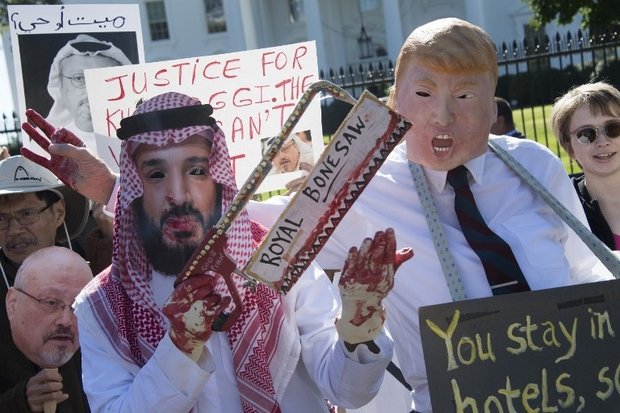Iran, Saudi Arabia and a history of American aggression

Tehran has repeatedly delivered on its promises, while Washington has fallen short and backed Riyadh’s disastrous regional adventures
In a recent op-ed in The New York Times, Thomas Friedman criticised former US President Barack Obama's bet on Iran and President Donald Trump’s bet on Saudi Arabia, noting that both countries responded with their worst impulses.
Friedman argues that the Iran nuclear deal was a bet worth making, but like many critics of the deal, he claims that it enabled Iran’s overreach in four Arab capitals: Baghdad, Damascus, Sanaa and Beirut. I believe he is wrong.
In the Iran-US wrangling over the past three decades, Tehran has repeatedly delivered on its promises, while the US has fallen short. In the late 1980s, President George HW Bush askedIran to help with the release of Western hostages in Lebanon, vowing “goodwill for goodwill”. Iran facilitated the release; in return, the US increased pressure on Iran.
The 'axis of evil'
In 2001, when the US asked for Iran’s support in its "war on terror" in Afghanistan, Iran’s Revolutionary Guard Corps gave crucial intelligence to the US military. Tehran also played a constructive role in Afghanistan by throwing its full support behind the US-backed president, Hamid Karzai - but President George W Bush responded by putting it on the "axis of evil".
According to Ryan Crocker, the former US ambassador to Afghanistan and Iraq, Iranian diplomats were "pragmatic and focused" when it came to assisting in Afghanistan, at one point even producing “an extremely valuable map showing the Taliban’s order of battle just before American military action began”.
That all ended after the infamous "axis of evil" speech, as the Iranian leadership “concluded that in spite of their cooperation with the American war effort, the United States remained implacably hostile to the Islamic Republic”.
Iran also delivered on its promises in the 2015 nuclear deal. The International Atomic Energy agency repeatedly confirmed that Iran was upholding its end of the bargain - but not only did the US withdraw from the deal, it has also since engaged in a maximum pressure policy, aiming to force Iran to capitulate to its demands.
In his recent statement, Trump launched straight into an attack on Iran as the root of all evil, rather than immediately addressing what was meant to be the subject at hand, namely Saudi Arabia and the killing of journalist Jamal Khashoggi. Trump should also know that 15 of the 19 hijackers who perpetrated the 9/11 attacks on the United States were Saudis. There was not even one Iranian among them.
In each of the important episodes outlined above, Iran respected the rules of the game, while the US reneged on its promises. It is also important to recall that Iran's engagements throughout the region predated the nuclear deal. After the 2003 US invasion of Iraq, Iran intervened in Iraq only after a number of US officials openly called for an American invasion of Iran to follow that of Iraq.
In Syria, Iran's involvement has not happened in a vacuum, either.
Projecting Saudi power
On Saudi Arabia, Friedman argues that Trump vowed to advance US interests in the region by selling $110bn in arms to Saudi Arabia and betting on Crown Prince Mohammed bin Salman - but bin Salman "used his carte blanche" to project power and stretch far beyond his capabilities by intervening in Yemen, blockading Qatar, abducting the prime minister of Lebanon, cracking down on female activists and "permitting, if not ordering, his team to murder moderate Saudi democracy advocate Jamal Khashoggi".
Friedman is wrong about Saudi Arabia too. The wars in Yemen, Syria and Libya have all been joint Saudi-US campaigns. Moreover, Washington and Riyadh jointly supported Saddam’s invasion of Iran and the use of chemical weapons against Iranians. The US turned a blind eye to Saudi Arabia, even though it was well aware of the latter’s support for extremist groups.
In the 1990s, the Saudis heavily funded madrassas that taught a fundamentalist version of Islam, Obama acknowledged, according to a 2016 Atlantic article. The US-backed Saudi campaign in Yemen has led to the world’s worst humanitarian disaster, and has bolstered extremist groups in the region and beyond. Even after the gruesome murder of Khashoggi, the US imposed severe sanctions on Iran, but did nothing to punish Saudi Arabia.
U.S. domination
There is no doubt that Obama’s strategy was different from Trump’s. “The competition between the Saudis and the Iranians - which has fuelled proxy wars and chaos in Syria and Iraq and Yemen - requires us to say to our friends as well as to the Iranians that they need to find an effective way to share the neighbourhood and institute some sort of cold peace,” Obama told the Atlantic. Yet, despite the Khashoggi affair, Saudi Arabia today lies at the centre of Washington’s strategic and political policy in the region.
The Middle East has been dominated by the US for decades. Multiple wars in the region - from Afghanistan, to Iraq, to Libya, to Yemen - are the real source of instability, sectarian conflict and the rise of terrorist groups such as the Islamic State (IS) and al-Qaeda. “Iran has not launched an aggressive war in modern history (unlike the US or Israel), and its leaders have a doctrine of ‘no first strike’," notes University of Michigan history professor Juan Cole.
While the West and some regional actors are concerned about Iran’s regional influence, Tehran also has serious and legitimate concerns. As a confidence-building measure, all parties to the nuclear deal - including the US - should respect their obligations to foster peace and stability in the Middle East.
